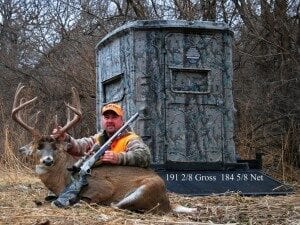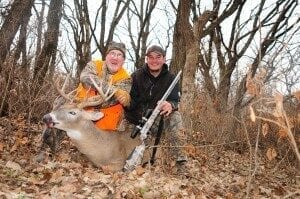LISTEN TO THE PODCAST HERE:
Tom Bulloch Consultant to the rifle scope industry – one of those lucky people gets to combine business with pleasure


I’m very pleased to have a 20-year consultant to the rifle scope industry, Mr. Tom Bulloch on our show today. Tom, welcome to the show.
Tom: Thank you, Bruce.
Bruce: Tom, with 20 years experience in this industry, you must have seen just about everything that’s come down the pike, and in the whitetail world we know that we’ve got the hardwoods of New England, the pine forests of the South, the plains of Kansas and Nebraska and the Dakotas, and all other places whitetails live. How important is the right scope in those places?
Tom: Well, Bruce, you’re right. There have been a lot of changes in recent years. A lot of new developments. Oddly enough, I can tell you that rifle scopes in general are probably one of the most misunderstood aspects of the whole hunting and shooting business. There are a lot of self-styled experts out there, but the truth is very, very few people know and understand, I certainly didn’t, what makes a good rifle scope, why a good rifle scope is worth the money, and how it applies to your hunting. So yeah, I have to say I’ve become kind of a scope snob in recent years, the more I learn about scopes and how important they are. Anymore I don’t care about the rifle I care about the rifle scope that’s on it.
Bruce: Tom, you and I shared a hunt last Fall at Iowa Trophy Whitetail Outfitters in Iowa with Judd Cooney and Sheri Yarborough, and we had some neat conversations around the kitchen table there about what it takes to make a good scope, but more importantly the importance of having the ability to see at low light. Can we talk about that for a little bit?

Tom: Be glad to, Bruce. And you’re right, that was an interesting example, because of course that was a muzzleloading hunt. And a lot of people think, “Well, what do you need a good rifle scope to go muzzleloading? You’re not gonna be shooting at 1,000 yards or 500 yards or anything remotely close to that.” But the principles of, and attributes that make a good rifle scope apply whether you’re shooting at 100 yards or 1,000 yards. I’m glad you brought up low-light performance and light transmission because that is one of the most misunderstood areas of optics in the industry. First of all, there’s no such thing as a light gathering scope. You may hear that, “Oh, our scope really gathers light.” Well, no, it’s impossible. A rifle scope cannot gather light. All it can do is transmit the available light. And here’s where you get into what separates a really good rifle scope from an average rifle scope, and light transmission is one of them. The best rifle scopes on the market will transmit 85 to 90% of the available light. The light that you see. Lesser scopes, substantially less.
And the human eye can distinguish differences of three to four percent in light transmission, so as you can see if you’ve got a rifle scope capable of 90% light transmission versus a cheap scope that maybe does 60 or 70%, that’s quite a difference, and that is what will make all of the difference at first light or last light. In fact, I had, several years ago I had one of the most famous rifle scope companies in the world tell me, “If you only hunt deer at noon you don’t need one of our scopes.” I was surprised to hear him say that but it’s true. Low light and bad weather, overcast, snow, that’s when the qualities of a rifle scope really pay off. Now on the muzzleloading hunt you mentioned I was using a Nightforce 1-4, which I’m very partial to Nightforce. It’s one of the premium brands out there, certainly. They say, “Well why do you need a scope that good on a muzzleloader?” Well, when are you most likely to see a whitetail? First light, last light. And you know, Bruce, when you’ve got a lot of money invested in a hunt whether it’s a guided hunt or whether it’s just the cost of filling your truck up and going down, driving down the road for a couple hours.
Hunting is expensive. So when you pull that trigger you wanna know, you wanna make sure of what you’re shooting at and that means it’s not just light transmission and it’s not just being able to see an animal. Being able to identify that animal. How many points does it have? Can I get a good estimate on the spread? The size? So on and so forth. And really these days you can go to any store, buy any rifle, and it’s gonna be capable of shooting pretty good groups. Probably inch or sub-one inch or less groups at a hundred yards. But the old saying is if you can’t see, it you can’t hit it. So it really all starts with your rifle scope wherever you are hunting whitetail.
Bruce: Let’s talk about low-light or dawn-dusk situations. What type of reticle is the most prevalent or the best to use?

Tom: Well, you know there’s a couple things I’d like to address there. Reticles can be a really confusing issue. In recent years you’ve seen a rise in popularity of so-called ballistic reticles. Which, some of them they have yardage markings. You can tailor your loads to the reticle so you don’t have to guess at hold-over, that sort of thing. And some very complicated MOA-based reticles which really have their origins with the military and professional snipers, which can do some really sophisticated range-finding. . .You have to be careful with that. In the hands of a very, very accomplished shooter, and primarily shooters are gonna be shooting at extended ranges. And I mean a thousand yards or more. The very complex ballistic reticles can be really good. But, I know for me, just an average hunter, and for most average hunters reticles like that can get very complicated. And you and I both know when that deer steps out your heart starts pounding and your palms get wet and start shaking all over, at least I do. And the last thing you want is anything that’s going to complicate the issue. So really for hunting I prefer, my advice is the simpler the better. And you don’t want a reticle that’s too thick and too heavy, because that can obscure the target at long ranges.
One of the best configurations, and there’s many variations, but really just something with good, heavy posts at the three, six, and nine o’clock, maybe the 12 o’clock position. Then it narrows down into some relatively fine cross-hairs in the center. So that gives you the combination of quick target acquisition. The heavy posts if you have to make a running shot or a snap-shot can get on the target quickly, but the finer cross-hairs then allow you to make a precision shot at longer ranges. So and different eyes see reticles differently, too. Illuminated reticles have become very popular and that can be quite helpful at very first light or very last light because you’ve got dark cross-hairs against a dark animal. The illumination can help a great deal. They’re not legal everywhere, so you have to be careful about that. But I say, my general advice, make sure you can see the reticle in all lighting conditions and keep it relatively simple because I know, at least for me, I’m excited enough when that deer steps out. I don’t need any more to think about than is necessary.
Bruce: Agreed, well said. Let’s talk about magnification. You and I live in Colorado, but there’s people throughout the Eastern part of the country that may only have a 50-yard shot.
Tom: That’s right.
Bruce: Or others like you and I, we might have a shot as far as we are capable of taking.
Tom: Or beyond what we’re capable of taking, entirely possible.
Bruce: True.
That’s why that little 1-4 I used on my muzzle-loading hunt, that Nightforce, it’s one of the few true one-power scopes on the market.

Tom: That’s a good point, Bruce. Another fairly recent development in rifle scopes is ever-higher and higher magnification levels. And that’s a mixed blessing. That’s why that little 1-4 I used on my muzzle-loading hunt, that Nightforce, it’s one of the few true one-power scopes on the market. So obviously one power, you say, “Why would you want a 1-power scope?” Well it gives you a tremendously wide field of view and it’s exactly what your eye sees. Up to 4-power still let’s you make, if you had to make a longer shot even out to several hundred yards that gives you plenty of magnification. Now a lot of hunters these days would say, “Wow, look at this. It’s a new 12-800 power rifle scope. Gees, I can shoot something on the moon with that.” Well, there are a couple of inherent draw-backs, several actually.
Please subscribe, rate and review each @WhitetailRendez podcast at http://getpodcast.reviews/id/1032967565
